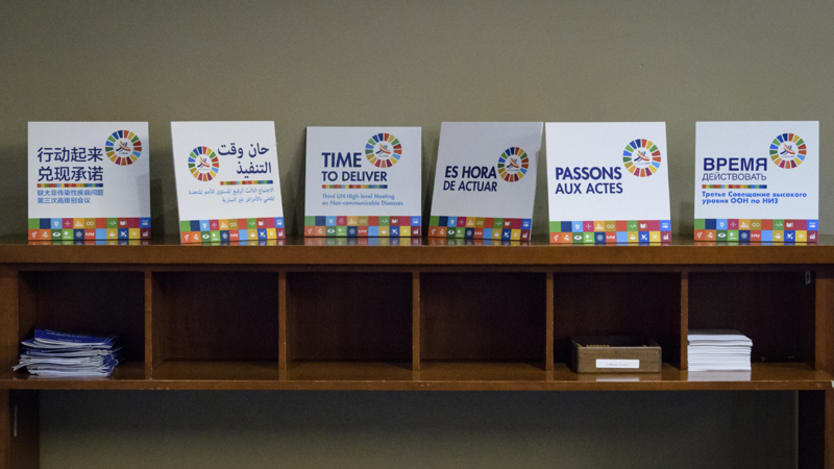
The world ends not with a bang but with a whimper, goes a famous poem by T.S. Eliot. Much the same can be said for the latest would-be milestone in the global fight against noncommunicable diseases — the third high-level meeting on NCDs, which fell flat after months of anticipation within the global health community.
While the high-level meeting presented an opportunity for bold action on NCDs by governments and nonstate actors alike, many of the more rigorous solutions and accountability mechanisms proposed by civil society and health policymakers were ignored in favor of “business as usual” — a dangerous continuation of the lack of progress we saw with the first two high-level meetings.
However, while discouraging, it’s important to remember that this isn’t a lost cause and, as NCD advocates, we are not powerless. There are distinct actions the NCD community can take to realize the changes we want to see.
1. Give young minds a seat at the table
The third high-level meeting was meant to serve as a platform for collecting and sharing exciting ideas from a wide array of interested parties, but the youth voice was woefully underrepresented. This isn’t for lack of effort.
In the past few years, an increasing number of youth events have sought to promote the youth voice in policy agendas. The mindset behind these events, however, is misguided. While it’s great to see more ambassador programs, more young faces on discussion panels, and more young people named as stakeholders on official policy documents, youth engagement has become little more than a catchphrase, but we as youth are more than just buzz.
“Endless panel discussions aren’t the way to inspire us to act.”
—Youth engagement in health policy is about more than just gaining work experience, networking, or climbing the career ladder to tick off the boxes in a 10-year plan. Many young people are deeply concerned about the future of our communities and our world and we have the radical, innovative mindset to create lasting change — but endless panel discussions aren’t the way to inspire us to act.
Even within formal events such as the United Nations General Assembly, there’s plenty of room to give attendees — be they younger, older, or simply young at heart — a chance to engage on tough topics. However, at so many events, we find ourselves being talked to rather than spoken with. Let’s think of ways to change that, perhaps by including youth in the decision-making process from the very beginning, to bring both perspective and skills to the cocreation process.
2. Give “NCD speak” a makeover
More on youth and NCDs:
► Doing it for the kids: Engaging youth to help lift burden of NCDs
► Street art breaks down barriers to discuss NCDs with Gen Z
► Cities and NCDs: The growing threat of childhood obesity in Quito
If the limits of one’s language are, as Ludwig Wittgenstein famously wrote, the limits of our world, then a discussion is long overdue about the language currently used to frame the issue of NCDs and the limits it places on the success of the movement — starting with the term “NCD” itself, which is often a source of confusion for those outside health circles.
There has been a major push to include people living with NCDs as part of the stakeholder group involved in policy discussions, but having so many unique illnesses included under the wide-brimmed umbrella of NCDs makes it especially difficult to humanize or generate a sense of urgency around any particular illness.
The more we paint NCDs with a broad brush, the less attention we are giving to personal details and experiences — and the more NCDs as a whole become a marginal issue, to be discussed only among the ranks of the few with an understanding of the technical speak.
3. Bring on the paradigm shift
To fight a dominant sense of inertia, unorthodox thinking will be the solution. Essentially, the global fight against NCDs requires an update to its user interface. In other sectors, disruptive developments have focused on bringing the complexities of the outside world to the end user in a collated and simplified format.
Why run out into the rain searching for a taxi when an Uber can be called at the touch of a button? Why travel from shop to shop with an ever-more-cumbersome pile of shopping bags when Amazon can deliver straight to your door? So why not apply some new ideas to change the way end users — the wider public we’re advocating to — deal with the threat of NCDs?
Instead of waiting for governments to be convinced and enact sensible policy options, we can take this chance to democratize the situation. We can pilot power-sharing plans for decision-making back to cities or communities rather than national or supranational decision-making, creating a platform where effective policies can be modeled using unique community parameters.
“The more we paint NCDs with a broad brush, the less attention we are giving to personal details and experiences — and the more NCDs as a whole become a marginal issue, to be discussed only among the ranks of the few with an understanding of the technical speak.”
—For example, we could look at disability-adjusted life years — an algorithm that calculates lost years of life due to disease — gained or the specific effects of certain WHO Best Buys being implemented rather than more lofty visions outlined in the Sustainable Development Goals. Communities could then decide on the policies they appreciate best and take the lead to implement them on a wider scale to address NCDs.
In the face of today’s global consumer culture, we NCD advocates have a choice: We can either wait for global power systems to enact robust mechanisms that will prevent individuals from developing NCDs, or we can devolve power back to the individuals — the users — themselves. Only this kind of youthful anarchism can help break the stalemate of “technocratism” currently stifling innovation in the NCD community.
Under the apathetic status quo, we’re facing a scary reality — at best, we’ll see limited progress toward meeting the #beatNCDs goals; at worst, we’ll see stagnation in NCD disease burden management. If we harness it as such, the anticlimactic nature of the third high-level meeting could be the rude awakening we need to inspire a radical change in direction on NCD policy.
This is the NCD community’s chance to take a long look at ourselves, an opportunity to recognize that there’s no excuse for falling down the same rabbit hole three times in a row. The time to push ourselves to think and act is now, and we young people are raring to go. Are you?
For more coverage of NCDs, visit the Taking the Pulse series here.










